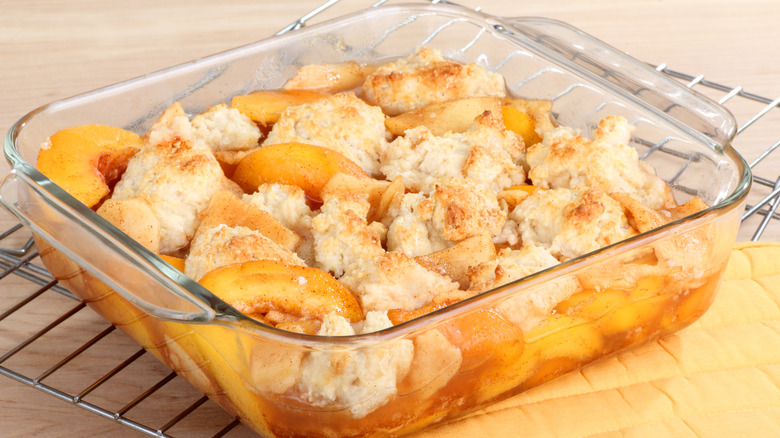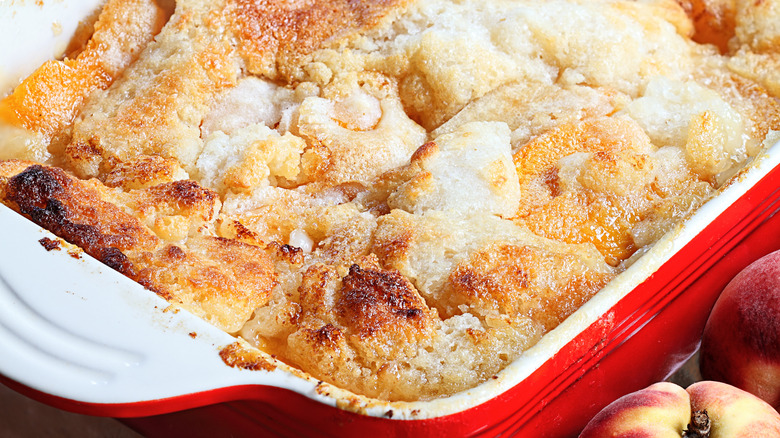The Difference Between Traditional And Texas-Style Peach Cobbler
Everyone knows that there's something special about the homely charm of peach cobbler that gives it its soul-warming appeal. But what you might not know is that this beloved dessert has a regional variation that gives it a unique twist. While you can find peach cobbler in most places, it is its Texan counterpart, Texas-style peach cobbler, that takes this cozy dessert to another level.
So, what exactly is so different about this Texas variation? While most things are bigger in Texas, that isn't exactly the case for the Lone Star State's take on peach cobbler. Ultimately, the two types of cobbler have the same integral components but with slight adjustments. Traditional peach cobbler tends to have a sweeter filling with a less sweet, biscuit-like layered topping baked on the surface.
Texas-style peach cobbler, meanwhile, lets the peaches shine on their own while introducing the dessert's sweetness through a rich, buttery topping that's poured into the bottom of the pan, allowing the peaches to sink into the cake-like batter. Each brings its own delightful character to the table while maintaining a well-balanced dish. But, to understand how their components really set the two variations apart, let's dive into the delicious differences between them.
What exactly is traditional peach cobbler?
Traditional peach cobbler is a classic American dessert that has been gracing dining tables for generations. At its core, it's a simple yet delectable treat consisting of ripe, juicy peaches tossed in sugar and nestled beneath a flaky topping, all baked together to sweet, syrupy perfection. But the hallmark of a traditional peach cobbler truly is its biscuit-like topping. This topping is typically buttery, crumbly, and mildly sweet, with a texture that ranges from tender to slightly crispy. It forms a delightful contrast to the soft, gooey peaches underneath.
In traditional peach cobbler, the peaches themselves are often the star of the show in terms of sweetness. They're typically sweetened with sugar and sometimes seasoned with a touch of cinnamon or nutmeg to enhance their natural flavors. Canned peaches, however, can also be used to make this dessert. The biscuit topping, while providing a hint of sweetness, primarily serves as a tender, slightly savory counterpart to the sugared peaches. This harmonious blend of fruit and flaky biscuit makes for a perfectly balanced dessert, ensuring that the cobbler does not become tooth-achingly sweet.
This is what makes Texas-style peach cobbler unique
What distinguishes Texas-style peach cobbler is its approach to sweetness. In this version, the peaches themselves are not overly sweetened, allowing their natural flavors to shine through. Instead, the sweetness predominantly comes from the topping. The batter is generously sweetened, infusing the cobbler with a rich, sugary essence that marries beautifully with the juicy, mildly sweet peaches.
In Texas-style peach cobbler, the topping veers away from the biscuit-like crust and leans more towards a cake-like or pancake-like batter. This buttermilk-infused batter has a richer, denser texture compared to the flaky composition of traditional cobbler topping. It forms a thick, golden layer that blankets the peaches, creating a delightful textural contrast between the moist, fluffy topping and the tender peaches beneath. The more uniform, cake-like texture that envelops the peaches also makes it feel like a more cohesive dessert.
It's simply a different approach to a balanced, satisfyingly delicious cobbler that isn't too sweet. So, choosing a cobbler recipe is really a matter of personal preference and regional influence. Both variations showcase the versatility and adaptability of peach cobbler, making it a dessert that can cater to a wide range of tastes and preferences. Whichever you choose, one thing is certain: A warm serving of peach cobbler, be it traditional or Texas-style, is a comfort that captures the essence of home and hospitality, one sweet bite at a time.


